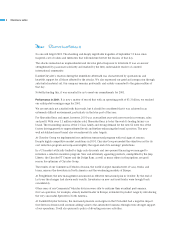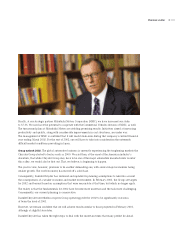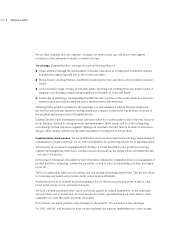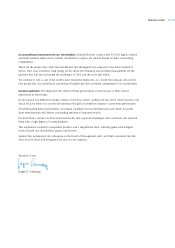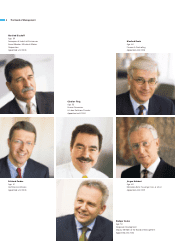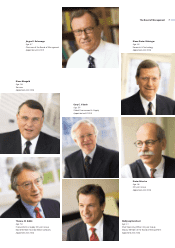Mercedes 2001 Annual Report Download - page 16
Download and view the complete annual report
Please find page 16 of the 2001 Mercedes annual report below. You can navigate through the pages in the report by either clicking on the pages listed below, or by using the keyword search tool below to find specific information within the annual report.
12 Outlook
Slow recovery of world economy. As a consequence of
the generally difficult economic conditions in the world,
which have further deteriorated since the terrorist
attacks on the United States, we have re-examined and
adjusted our assumptions for the development of global
economic activity, particularly for the year 2002. We
now assume that the economic upturn originally ex-
pected for the end of 2001 is only likely to begin in the
second half of 2002, and then gather pace. We antici-
pate global economic growth of 1.4% in 2002, 3.4% in
2003 and 3.2% in 2004. The economies of the United
States and Western Europe should return to a path of
stable growth within the planning period, whereas the
Japanese economy will probably only begin to emerge
from recession. We do not expect above-average growth
in the emerging economies of Asia, South America or
Eastern Europe before 2003.
Intensified competition in the automotive industry.
Against this macroeconomic backdrop we have also
revised our projections for automotive markets. In the
year 2002 we now expect a significant decline in the
market for passenger cars and light trucks in North
America, and a moderate weakening of demand in
Western Europe and Japan. Demand in Western Europe
for trucks over 6 tons is likely to be distinctly lower
Continuous improvement in profitability
■DaimlerChrysler Group: significant earnings improvement
expected in 2002 and beyond
■Executive Automotive Committee (EAC) established as an implementation platform
for Group strategy
■Further growth at Mercedes-Benz Passenger Cars & smart
■Turnaround measures reinforced at Chrysler Group and Freightliner
■Services division to continue focusing on automotive business
■Investment in products and innovation to secure competitiveness
than last year, whereas demand in the US market
might continue to fall. The worldwide economic revival
expected to begin in the second half of 2002 should
have positive effects on automotive markets, with sales
increasing in 2003 and 2004. Generally difficult market
conditions, shorter product lifecycles and high produc-
tion capacities will intensify competition and increase
the pressure to cut costs in all market segments, which
in turn should accelerate consolidation in the industry.
Continuous improvement in profitability at
DaimlerChrysler. In order to counteract unfavorable
market developments we will continue to implement
the restructuring measures introduced in 2001, and
will actually strengthen them in some areas. However,
the fundamentals have now become more difficult and
the task more challenging. DaimlerChrysler neverthe-
less expects Group operating profit for 2002 excluding
one-time effects to exceed twice the 2002 level by a
very significant amount. We are confident that we will
achieve the results announced in February 2001, but at
slightly later dates. Not only the turnaround plans will
contribute to this, but also the enhanced coordination
of our global activities and the resulting cost reduc-
tions, a more favorable market situation, and many
attractive new products.
The Outlook section and other sections in this Annual Report contain forward-looking statements that reflect the current views of
DaimlerChrysler management with respect to future events. The words “anticipate,” “believe,” “estimate,” “expect,” “intend,” “may,” “plan,”
“project” and “should” and similar expressions are intended to identify forward-looking statements. Such statements are subject to risks and
uncertainties, including, but not limited to: changes in general economic and business conditions, especially an economic downturn in
Europe or North America; changes in currency exchange rates and interest rates; introduction of competing products; lack of acceptance of
new products or services, including increased competitive pressures on the general level of sales incentives and pricing flexibility; inability
to implement the turnaround plans for the Chrysler Group and Freightliner promptly and successfully, especially an inability to meet
revenue enhancement, efficiency and cost reduction initiatives; the ability of Mitsubishi Motors to implement its restructuring plan
successfully; and decline in resale prices of used vehicles. If any of these or other risks and uncertainties occur (some of which are described
under the heading “Analysis of the Financial Situation” in this Annual Report) , or if the assumptions underlying any of these statements
prove incorrect, then actual results may be materially different from those expressed or implied by such statements. DaimlerChrysler does
not intend or assume any obligation to update these forward-looking statements. Any forward-looking statement speaks only as of the date
on which it is made.


